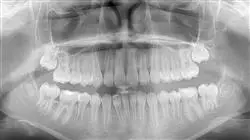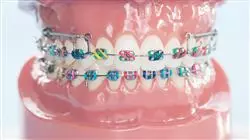University certificate
The world's largest faculty of dentistry”
Introduction to the Program
The Advanced master’s degree in Orthodontics and Dentofacial Orthopedics allows you to acquire the most updated specialization in all areas of dentistry and dentofacial orthopedics: A special program, of greater intensity, duration and impact, created to provide a highly qualified response to the most demanding professionals”

Dentofacial Orthopedics aims to correct the width, length, or height of the jaws; to stimulate or inhibit jaw growth when it is altered; or to improve dental eruption. But there are other abnormalities that can be prevented or cured thanks to this specialty, such as the reduction or elimination of dental crowding; the correction of habits such as thumb sucking or abnormal swallowing, or asymmetry problems, as well as preserving spaces for permanent teeth that have not yet erupted. All these treatments have seen changes in the way they work and intervene in recent times, with the irruption of new materials, work systems and methodologies that increase treatment success, optimize treatment time and achieve a greater cost-work benefit for professionals.
Moreover, the demand for orthodontic treatment has increased. Earlier and earlier intervention has turned children into patients, sometimes at a very young age. And conversely, also older patients of ages that were not previously common in this field.
This makes up-to-date specialization an inexcusable necessity for all professionals in these fields of work. In-depth knowledge of new developments and possible answers to special conditions is the only way to offer patients the most appropriate means of improvement under optical conditions.
Intensive training is the only way to remain competitive and to offer first-class quality care. A stance that is becoming the only way to achieve job objectives in an increasingly demanding market.
An Advanced master’s degree created especially for professionals seeking the highest qualification, with the best didactic material, working on real cases and learning from the best professionals in the field”
This Advanced master’s degree in Orthodontics and Dentofacial Orthopedics is the most complete and up-to-date scientific program on the market. The most important features of the program include:
- Clinical cases presented by experts in the different specialties. The graphic, schematic, and eminently practical contents with which they are created provide scientific and practical information on the disciplines that are essential for professional practice
- The latest innovations in diagnosis, intervention, treatment and new materials
- Presentation of practical workshops on techniques and procedures
- Real high-resolution images in demonstrations
- Practical exercises where the self-evaluation process can be carried out to improve learning
- Algorithm-based interactive learning system for decision-making in the presented clinical situations
All of this will be complemented by theoretical lessons, questions to the expert, debate forums on
controversial topics, and assignments - Content that is accessible from any fixed or portable device with an Internet connection
This Advanced master’s degree may be the best investment you can make when choosing a refresher program for two reasons: in addition to updating your knowledge of Odontology, you will obtain a qualification from TECH Global University: the world's largest and most prestigious digital educational institution in Spanish”
The teaching staff includes health professionals from the field, who bring their experience to this program, as well as renowned specialists from leading scientific societies.
The multimedia content developed with the latest educational technology will provide the professional with situated and contextual learning, i.e., a simulated environment that will provide an immersive training program to train in real situations.
This program is designed around Problem Based Learning, whereby the professional must try to solve the different professional practice situations that arise during the course. For this reason, you will be assisted by an innovative, interactive video system created by renowned and experienced experts in the field of Odontology with extensive teaching experience.
Increase your decision-making confidence by updating your knowledge through this Two Year Master’s Degree of a program created to train the best"

Make the most of this opportunity and learn about the latest advances in Orthodontics and Dentofacial Orthopedics and improve patient care, offering them the latest treatments and most innovative techniques: the most guaranteed way to position yourself among the best"
Why study at TECH?
TECH is the world’s largest online university. With an impressive catalog of more than 14,000 university programs available in 11 languages, it is positioned as a leader in employability, with a 99% job placement rate. In addition, it relies on an enormous faculty of more than 6,000 professors of the highest international renown.

Study at the world's largest online university and guarantee your professional success. The future starts at TECH”
The world’s best online university according to FORBES
The prestigious Forbes magazine, specialized in business and finance, has highlighted TECH as “the world's best online university” This is what they have recently stated in an article in their digital edition in which they echo the success story of this institution, “thanks to the academic offer it provides, the selection of its teaching staff, and an innovative learning method aimed at educating the professionals of the future”
A revolutionary study method, a cutting-edge faculty and a practical focus: the key to TECH's success.
The most complete study plans on the university scene
TECH offers the most complete study plans on the university scene, with syllabuses that cover fundamental concepts and, at the same time, the main scientific advances in their specific scientific areas. In addition, these programs are continuously being updated to guarantee students the academic vanguard and the most in-demand professional skills. In this way, the university's qualifications provide its graduates with a significant advantage to propel their careers to success.
TECH offers the most comprehensive and intensive study plans on the current university scene.
A world-class teaching staff
TECH's teaching staff is made up of more than 6,000 professors with the highest international recognition. Professors, researchers and top executives of multinational companies, including Isaiah Covington, performance coach of the Boston Celtics; Magda Romanska, principal investigator at Harvard MetaLAB; Ignacio Wistumba, chairman of the department of translational molecular pathology at MD Anderson Cancer Center; and D.W. Pine, creative director of TIME magazine, among others.
Internationally renowned experts, specialized in different branches of Health, Technology, Communication and Business, form part of the TECH faculty.
A unique learning method
TECH is the first university to use Relearning in all its programs. It is the best online learning methodology, accredited with international teaching quality certifications, provided by prestigious educational agencies. In addition, this disruptive educational model is complemented with the “Case Method”, thereby setting up a unique online teaching strategy. Innovative teaching resources are also implemented, including detailed videos, infographics and interactive summaries.
TECH combines Relearning and the Case Method in all its university programs to guarantee excellent theoretical and practical learning, studying whenever and wherever you want.
The world's largest online university
TECH is the world’s largest online university. We are the largest educational institution, with the best and widest online educational catalog, one hundred percent online and covering the vast majority of areas of knowledge. We offer a large selection of our own degrees and accredited online undergraduate and postgraduate degrees. In total, more than 14,000 university degrees, in eleven different languages, make us the largest educational largest in the world.
TECH has the world's most extensive catalog of academic and official programs, available in more than 11 languages.
Google Premier Partner
The American technology giant has awarded TECH the Google Google Premier Partner badge. This award, which is only available to 3% of the world's companies, highlights the efficient, flexible and tailored experience that this university provides to students. The recognition as a Google Premier Partner not only accredits the maximum rigor, performance and investment in TECH's digital infrastructures, but also places this university as one of the world's leading technology companies.
Google has positioned TECH in the top 3% of the world's most important technology companies by awarding it its Google Premier Partner badge.
The official online university of the NBA
TECH is the official online university of the NBA. Thanks to our agreement with the biggest league in basketball, we offer our students exclusive university programs, as well as a wide variety of educational resources focused on the business of the league and other areas of the sports industry. Each program is made up of a uniquely designed syllabus and features exceptional guest hosts: professionals with a distinguished sports background who will offer their expertise on the most relevant topics.
TECH has been selected by the NBA, the world's top basketball league, as its official online university.
The top-rated university by its students
Students have positioned TECH as the world's top-rated university on the main review websites, with a highest rating of 4.9 out of 5, obtained from more than 1,000 reviews. These results consolidate TECH as the benchmark university institution at an international level, reflecting the excellence and positive impact of its educational model.” reflecting the excellence and positive impact of its educational model.”
TECH is the world’s top-rated university by its students.
Leaders in employability
TECH has managed to become the leading university in employability. 99% of its students obtain jobs in the academic field they have studied, within one year of completing any of the university's programs. A similar number achieve immediate career enhancement. All this thanks to a study methodology that bases its effectiveness on the acquisition of practical skills, which are absolutely necessary for professional development.
99% of TECH graduates find a job within a year of completing their studies.
Advanced Master’s Degree in Orthodontics and Dentofacial Orthopedics
Because treatments to correct and modify dental patterns continue to be one of the most prominent procedures in the field of dentistry, not only for its accessibility, but for its effective results, it is important that professionals are prepared to take on the challenges involved in integrating the latest advances in this area. At TECH Global University we have developed the Advanced Master’s Degree in Orthodontics and Dentofacial Orthopedics, a program aimed at addressing the most relevant aspects of this discipline to create, supervise and work with the most cutting-edge techniques during your consultations and ensure a service with the highest standards of quality.
Specialize in the world's largest School of Dentistry
Our Advanced Master's Degree will provide you with greater professional confidence to practice as a dentist specialized in this area. You will identify the indications, contraindications and limits of orthodontics, dentofacial orthopedics and orthognathic surgery; you will know how to diagnose, classify and plan the treatment of malocclusions, distinguishing between skeletal and dental problems. You will also apply the principles and mechanisms of action of fixed or removable appliances according to the type of malocclusion and/or the individual characteristics of the patient. At the largest School of Dentistry you will learn to manage in a coordinated, efficient and planned way the procedures of orthodontics and dentofacial orthopedics, from the simplest cases to those with a high degree of complexity.







